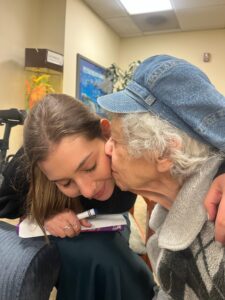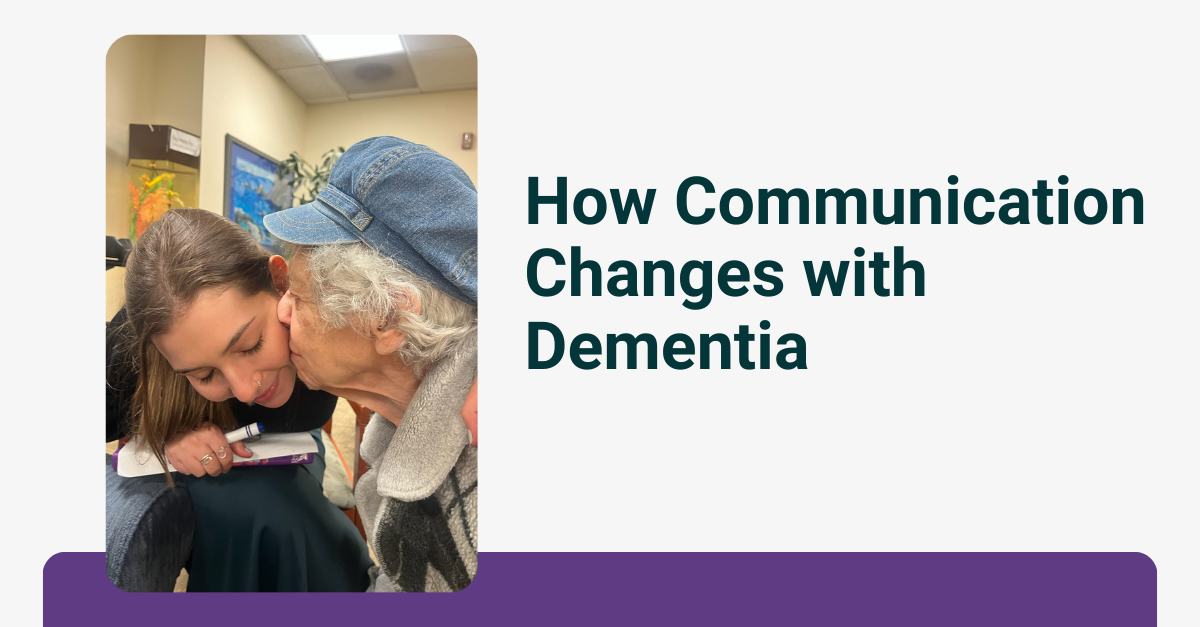 The past few months of visiting my mom at the memory care facility have been brief and challenging for many of our family members. They often feel unsure of how to interact with her since she can no longer engage in the meaningful conversations we once shared. My mom is now in the middle-late stage of dementia, and her communication abilities have been deeply affected.
The past few months of visiting my mom at the memory care facility have been brief and challenging for many of our family members. They often feel unsure of how to interact with her since she can no longer engage in the meaningful conversations we once shared. My mom is now in the middle-late stage of dementia, and her communication abilities have been deeply affected.
It’s become clear that approach is everything, and understanding how to best connect with her requires a shift in perspective. It’s no longer about the words, the stories, or the conversation itself—it’s about the connection. Her ability to engage in long, verbal exchanges has diminished, but the emotional bond remains strong. Now, it’s all about the moments of being together. The hugs and love, the loving eye contact, the quiet presence we share. While we may have lost her vibrant personality, her hearty laugh, and the deep conversations we once had, we still have her love—an unwavering presence that transcends words.
Understanding the Stages of Dementia
Dementia is a general term that refers to a decline in cognitive abilities, affecting memory, thinking, and reasoning. As the condition progresses, it significantly impacts daily life, particularly in the realm of communication. Understanding how communication changes with dementia is crucial for both caregivers and loved ones, as it allows them to foster more effective and compassionate interactions.
1. Early Stages: Subtle Changes in Communication
In the early stages of dementia, communication might still seem relatively normal, but subtle changes begin to emerge. Individuals may struggle to find the right words, repeat themselves more frequently, or lose track of conversations. These early signs are often mistaken for simple forgetfulness or aging, but they are indications that cognitive decline is beginning.
At this point, individuals with dementia may experience:
- Word-finding difficulties: They may pause in the middle of sentences or use vague terms (e.g., “the thing” instead of “the remote”).
- Occasional repetition: Asking the same question multiple times or repeating stories.
- Difficulty keeping up with complex conversations: They may have trouble following long or multi-step discussions.
For caregivers and family members, the key in the early stages is patience. Offering reassurance and providing time for the person to gather their thoughts can help reduce frustration. It’s also important to maintain eye contact and encourage short, clear communication.
2. Middle Stages: Increased Struggles with Language and Understanding
As dementia progresses to its middle stages, communication becomes more challenging. Word-finding difficulties become more pronounced, and individuals may start to forget familiar words or names. They might struggle to maintain coherent conversations, often speaking in disjointed sentences or using unrelated phrases.
At this stage, other common changes include:
- Loss of comprehension: The ability to understand spoken language declines, and individuals may not fully grasp what is being said to them.
- Increased reliance on non-verbal communication: Gestures, facial expressions, and body language become crucial for communication.
- Emotional responses: People with dementia may express emotions like frustration, anger, or confusion more easily, particularly when they struggle to communicate effectively.
Caregivers need to adapt by simplifying conversations, using short sentences, and avoiding complex or abstract concepts. It’s helpful to ask yes or no questions and provide choices, rather than open-ended questions, to reduce confusion. Non-verbal cues such as a comforting touch or maintaining a calm tone of voice can also ease communication.
3. Late Stages: Limited or No Verbal Communication
In the later stages of dementia, verbal communication often diminishes significantly or may cease altogether. The individual may be unable to speak or form sentences, and their ability to understand language may be severely impaired. As cognitive function declines, many individuals with dementia rely almost entirely on non-verbal communication.
Key changes in communication during this phase include:
- Loss of verbal communication: Speech becomes increasingly fragmented or may disappear entirely.
- Increased reliance on non-verbal cues: Facial expressions, gestures, and physical touch may become the primary means of communication
When Words Fade, Connection Remains
Even as words fade, connection remains. While my mom may no longer communicate the way she once did, she still responds to love, touch, and presence. A gentle hand squeeze, a familiar song, or simply sitting together in silence holds more meaning now than any conversation ever could. Dementia changes communication, but it doesn’t erase the bond we share. By adjusting our approach, we can continue to connect in ways that matter—because love, in its purest form, needs no words.

